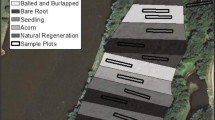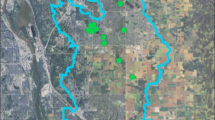Abstract
Survival of planted trees is commonly used as a performance metric for compensatory mitigation wetlands. However, establishing floodplain forest through planting is difficult due to flood-induced tree mortality. We used multiyear tree census and hydrologic data from 17 compensatory mitigation projects in Illinois, USA, to relate planted and volunteer tree establishment to flood frequency, depth, and duration. Annual survival of planted trees decreased with greater annual maximum flood depth and duration. By the end of official compliance monitoring, sites with greater flood exposure had greater planted tree mortality. We resurveyed 10 sites that were at least 10 years old, and found that long-term tree survival was significantly lower in sites with greater flood exposure. Naturally colonizing trees differed in species composition from planted trees; specifically, wind dispersed species were well-represented among volunteer trees, whereas hard mast species were absent. There was no clear relationship between volunteer tree recruitment and measured flood variables. Across all sites, compliance with tree survival standards was poor, but influenced by hydrologic conditions. Current performance standards for tree survival may be unrealistic in restored wetlands that are exposed to long-duration floods. Regulators and practitioners should seek alternative methods to establish desired floodplain forest structure and function.


Similar content being viewed by others
References
Acker SA, Gregory SV, Lienkaemper G, McKee WA, Swanson FJ, Miller SD (2003) Composition, complexity, and tree mortality in riparian forests in the central western cascades of Oregon. Forest Ecology and Management 173:293–308
Ahmad QK, Ahmed AU (2003) Regional cooperation in flood management in the Ganges–Brahmaputra–Meghna region: Bangladesh perspective. Natural Hazards 28:181–198
Allen JA (1997) Reforestation of bottomland hardwoods and the issue of woody species diversity. Restoration Ecology 5:125–134
Bates D, Maechler M, Bolker B, Walker S (2015) Fitting linear mixed-effects models using lme4. Journal of Statistical Software 67:1–48
Battaglia LL, Minchin PR, Pritchett DW (2002) Sixteen years of old-field succession and reestablishment of a bottomland hardwood forest in the lower Mississippi Alluvial Valley. Wetlands 22:1–17
Battaglia LL, Pritchett DW, Minchin PR (2008) Evaluating dispersal limitation in passive bottomland forest restoration. Restoration Ecology 16:417–424
Bell DT (1997) Eighteen years of change in an Illinois streamside deciduous forest. Journal of the Torrey Botanical Society 124:174–188
Bendix J (1999) Stream power influence on southern Californian riparian vegetation. Journal of Vegetation Science 10:243–252
Bendix J, Hupp CR (2000) Hydrological and geomorphological impacts on riparian plant communities. Hydrological Processes 14:2977–2990
Breaux A, Serefiddin F (1999) Validity of performance criteria and a tentative model for regulatory use in compensatory wetland mitigation permitting. Environmental Management 24:327–336
Cronk JK, Fennessy MS (2001) Wetland plants: biology and ecology. Lewis Publishers, Boca Raton
Damasceno-Junior GA, Semir J, dos Santos FAM, Leitão-Filho HF (2004) Tree mortality in a riparian forest at Rio Paraguai, Pantanal, Brazil, after an extreme flooding. Acta Botânica Brasílica 18:839–846
De Jager NR, Thomsen M, Yin Y (2012) Threshold effects of flood duration on the vegetation and soils of the upper Mississippi River floodplain, USA. Forest Ecology and Management 270:135–146
De Jager NR, Rohweder JJ, Yin Y, Hoy E (2016) The upper Mississippi River floodscape: spatial patterns of flood inundation and associated plant community distributions. Applied Vegetation Science 19:164–172
DeBerry DA, Perry JE (2012) Vegetation dynamics across a chronosequence of created wetland sites in Virginia, USA. Wetlands Ecology and Management 20:521–537
Environmental Law Institute (2004) Measuring mitigation: a review of the science for compensatory mitigation performance standards. Environmental Law Institute, Washington, DC
Ernst KA, Brooks JR (2003) Prolonged flooding decreased stem density, tree size and shifted composition towards clonal species in a Central Florida hardwood swamp. Forest Ecology and Management 173:261–279
Register F (2008) Compensatory mitigation for losses of aquatic resources; final rule. Federal Register 73(70):19594–19705
Glenz C, Schlaepfer R, Iorgulescu I, Kienast F (2006) Flooding tolerance of central European tree and shrub species. Forest Ecology and Management 235:1–13
Groninger JW (2005) Increasing the impact of bottomland hardwood afforestation. Journal of Forestry 103:184–188
Groninger JW, Baer SG, Babassana DA, Allen DH (2004) Planted green ash (Fraxinus pennsylvanica marsh.) and herbaceous vegetation responses to initial competition control during the first 3 years of afforestation. Forest Ecology and Management 189:161–170
Hall RBW, Harcombe PA (1998) Flooding alters apparent position of floodplain saplings on a light gradient. Ecology 79:847–855
Harrison XA (2014) Using observation-level random effects to model overdispersion in count data in ecology and evolution. PeerJ 2:e616
Hook DD (1984) Waterlogging tolerance of lowland tree species of the south. Southern Journal of Applied Forestry 8:136–149
Hovick SM, Reinartz JA (2007) Restoring forest in wetlands dominated by reed canarygrass: the effects of pre-planting treatments on early survival of planted stock. Wetlands 27:24–39
Howard JJ (2012) Hurricane Katrina impact on a leveed bottomland hardwood forest in Louisiana. The American Midland Naturalist 168:56–69
Hughes FMR, Adams WM, Muller E, Nilsson C, Richards KS, Barsoum N, Decamps H, Foussadier R, Girel J, Guilloy H, Hayes A, Johansson M, Lambs L, Patou G, Peiry JL, Perrow M, Vautier F, Winfield M (2001) The importance of different scale processes for the restoration of floodplain woodlands. Regulated Rivers: Research & Management 17:325–345
Hupp CR, Osterkamp WR (1985) Bottomland vegetation distribution along Passage Creek, Virginia, in relation to fluvial landforms. Ecology 66:670–681
Jacobs DF, Ross-Davis AL, Davis AS (2004) Establishment success of conservation tree plantations in relation to silvicultural practices in Indiana, USA. New Forest 28:23–36
Jarman NM, Dobberteen RA, Windmiller B, Lelito PR (1991) Evaluation of created freshwater wetlands in Massachusetts. Restoration and Management Notes 9:26–29
Johnson YB, Shear TH, James AL (2014) Novel ways to assess forested wetland restoration in North Carolina using ecohydrological patterns from reference sites. Ecohydrology 7:692–702
Kabrick JM, Dey DC, Van Sambeek JW, Coggeshall MV, Jacobs DF (2012) Quantifying flooding effects on hardwood seedling survival and growth for bottomland restoration. New Forest 43:695–710
King SL, Keeland BD (1999) Evaluation of reforestation in the lower Mississippi River Alluvial Valley. Restoration Ecology 7:348–359
Kozlowski TT (2002) Physiological-ecological impacts of flooding on riparian forest ecosystems. Wetlands 22:550–561
Kruse BS, Groninger JW (2003) Vegetative Characteristics of Recently Reforested Bottomlands in the Lower Cache River Watershed, Illinois, U.S.A. Restoration Ecology 11(3):273–280
Krzywicka AE, Pociask GE, Grimley DA, Matthews JW (2017) Hydrology and soil magnetic susceptibility as predictors of planted tree survival in a restored floodplain forest. Ecological Engineering 103:275–287
Lin J, Harcombe PA, Fulton MR, Hall RW (2004) Sapling growth and survivorship as affected by light and flooding in a river floodplain forest of Southeast Texas. Oecologia 139:399–407
Lockhart BR, Ezell AW, Hodges JD, Clatterbuck WK (2006) Using natural stand development patterns in artificial mixtures: a case study with cherrybark oak and sweetgum in east-Central Mississippi, USA. Forest Ecology and Management 222:202–210
Loučková B (2012) Vegetation-landform assemblages along selected rivers in the Czech Republic, a decade after a 500-year flood event. River Research and Applications 28:1275–1288
Marks CO, Nislow KH, Magilligan FJ (2014) Quantifying flooding regime in floodplain forests to guide river restoration. Elementa: Science of the Anthropocene 2:31
Matthews JW, Endress AG (2008) Performance criteria, compliance success, and vegetation development in compensatory mitigation wetlands. Environmental Management 41:130–141
Middleton B (2000) Hydrochory, seed banks, and regeneration dynamics along the landscape boundaries of a forested wetland. Plant Ecology 146:169–184
Middleton BA (2003) Soil seed banks and the potential restoration of forested wetlands after farming. Journal of Applied Ecology 40:1025–1034
Naiman RJ, Décamps H (1997) The ecology of interfaces: riparian zones. Annual Review of Ecology and Systematics 28:621–658
National Research Council (2001) Compensating for wetland losses under the clean water act. National Academy Press, Washington, DC
Pennington MR, Walters MB (2006) The response of planted trees to vegetation zonation and soil redox potential in created wetlands. Forest Ecology and Management 233:1–10
Peralta AL, Muscarella ME, Matthews JW (2017) Wetland management strategies lead to tradeoffs in ecological structure and function. Elementa: Science of the Anthropocene 5:74
R Core Team (2018) R: A language and environment for statistical computing. R Foundation for Statistical Computing, Vienna, Austria. URL https://www.R-project.org/. Accessed 20 Dec 2018
Richardson DM, Holmes PM, Esler KJ, Galatowitsch SM, Stromberg JC, Kirkman SP, Pyšek P, Hobbs RJ (2007) Riparian vegetation: degradation, alien plant invasions, and restoration prospects. Diversity and Distributions 13:126–139
Richter BD, Baumgartner JV, Powell J, Braun DP (1996) A method for assessing hydrologic alteration within ecosystems. Conservation Biology 10:1163–1174
Shear TH, Lent TJ, Fraver S (1996) Comparison of restored and mature bottomland hardwood forests of southwestern Kentucky. Restoration Ecology 4:111–123
Singer JD (1998) Using SAS PROC MIXED to fit multilevel models, hierarchical models, and individual growth models. Journal of Educational and Behavioral Statistics 24:323–355
Stanturf JA, Conner WH, Gardiner ES, Schweitzer CJ, Ezell AW (2004) Recognizing and overcoming difficult site conditions for afforestation of bottomland hardwoods. Ecological Restoration 22:183–193
Streever WJ (1999) Examples of performance standards for wetland creation and restoration in Section 404 permits and an approach to developing performance standards. U.S. Army Engineer Research and Development Center, WRP Technical Notes Collection, TN WRP WG-RS-3.3. Vicksburg, MS
Teskey RO, Hinckley TM (1977) Impact of water level changes on woody riparian and wetland communities, vol. 3. The central forest region. U.S. Fish and Wildlife Service, Washington, DC
Toner M, Keddy P (1997) River hydrology and riparian wetlands: a predictive model for ecological assembly. Ecological Applications 7:236–246
Turner MG, Gergel SE, Dixon ME, Miller JR (2004) Distribution and abundance of trees in floodplain forests of the Wisconsin River: environmental influences at different scales. Journal of Vegetation Science 15:729–738
Twedt DJ, Wilson RR, Henne-Kerr JL, Grosshuesch DA (2002) Avian response to bottomland reforestation: the first 10 years. Restoration Ecology 10:645–655
Urban DT (2008) Rule offers philosophy change to mitigation. National Wetlands Newsletter 30:5–7
USACE [United States Army Corps of Engineers] (2012) RiverGages.com: water levels of rivers and lakes. Available online at http://rivergages.mvr.usace.army.mil/WaterControl/new/layout.cfm. Accessed 19 April 2018
USACE [United States Army Corps of Engineers] Seattle District (2017) Riparian planting mitigation plan requirements. Available online at https://www.nws.usace.army.mil/Portals/27/docs/regulatory/permit%20guidebook/Mitigation/Riparian%20Planting%20Mit%20Plan%20Requirements%204-20-17.pdf?ver=2017-04-20-180500-970. Accessed 20 December 2018
USGS [United States Geological Survey] (2012) National Water Information System: web interface. Available online at http://waterdata.usgs.gov/il/nwis/rt. Accessed 19 April 2018
Van den Bosch K, Matthews JW (2017) An assessment of long-term compliance with performance standards in compensatory mitigation wetlands. Environmental Management 59:546–556
Walling DE, Teed A (1971) A simple pumping sampler for research into suspended sediment transport in small catchments. Journal of Hydrology 13:325–337
Yin Y (1998) Flooding and forest succession in a modified stretch along the upper Mississippi River. Regulated Rivers: Research & Management 14:217–225
Yin Y, Wu Y, Bartell SM, Cosgriff R (2009) Patterns of forest succession and impacts of flood in the upper Mississippi River floodplain ecosystem. Ecological Complexity 6:463–472
Acknowledgments
This publication is based on the results of ICT-R27-143, Tree Establishment in Response to Hydrology at IDOT Wetland Mitigation Sites. ICT- R27-143 was conducted in cooperation with the Illinois Center for Transportation; the Illinois Department of Transportation, Division of Highways; and the U.S. Department of Transportation, Federal Highway Administration. This research was additionally supported by the National Institute of Food and Agriculture, U.S. Department of Agriculture, under Hatch project 1001050. Original site monitoring was funded by the Illinois Department of Transportation and performed by staff of the Illinois Natural History Survey and Illinois State Geological Survey. Jordan Jessop and Christopher Castle assisted with field work in 2014.
Author information
Authors and Affiliations
Corresponding author
Additional information
Publisher’s Note
Springer Nature remains neutral with regard to jurisdictional claims in published maps and institutional affiliations.
Rights and permissions
About this article
Cite this article
Matthews, J.W., Pociask, G.E., Price, E.P.F. et al. Flood Exposure Affects Long-Term Tree Survival in Compensatory Mitigation Wetlands. Wetlands 39, 1129–1138 (2019). https://doi.org/10.1007/s13157-019-01158-7
Received:
Accepted:
Published:
Issue Date:
DOI: https://doi.org/10.1007/s13157-019-01158-7




